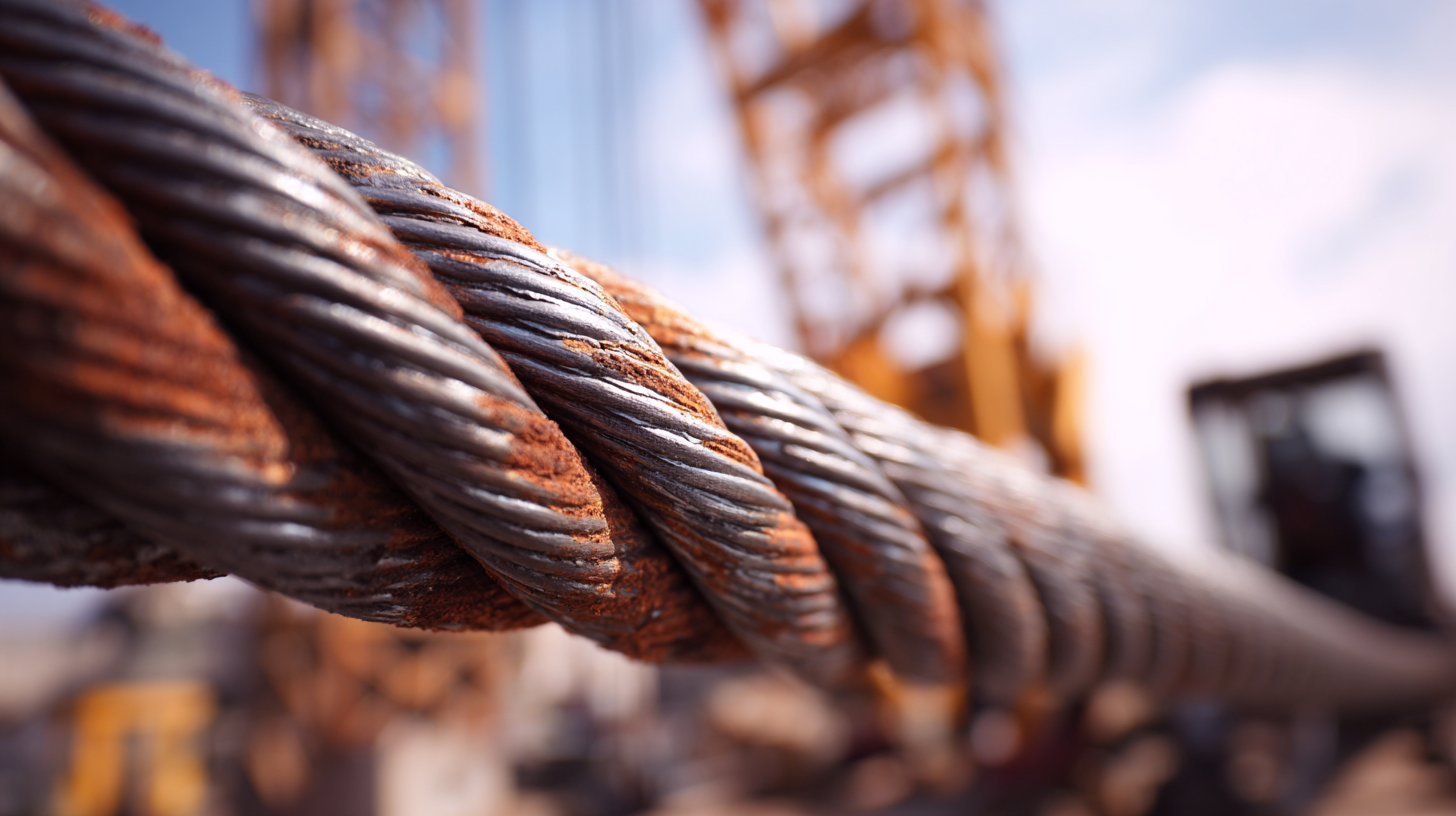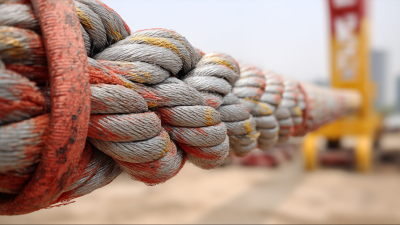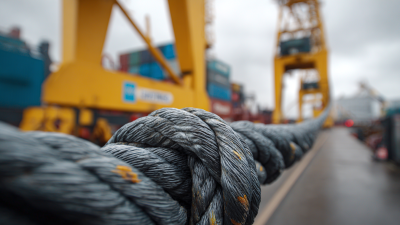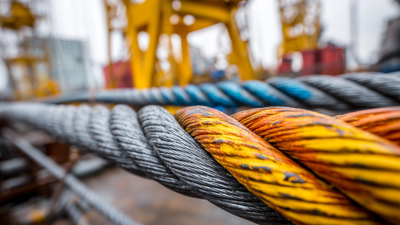Understanding the Importance of Durable Crane Steel Rope in Modern Construction
In the realm of modern construction, the significance of utilizing high-quality materials cannot be overstated, with
"Durable Crane Steel Rope" standing out as a pivotal component in the industry's toolkit.
As construction projects grow in scale and complexity, the demand for reliable and resilient materials has surged, making the choice of steel rope critical to ensuring operational efficiency and safety.
Durable Crane Steel Rope not only enhances the lifting capabilities of cranes but also augments their longevity and performance under strenuous conditions.
This article delves into the multifaceted advantages of employing durable steel ropes in construction, examining how they contribute to the foundation of contemporary building practices.
By understanding their role, construction professionals can make informed decisions that bolster both project outcomes and worker safety, ultimately establishing a standard for excellence in the industry.

Key Characteristics of Durable Crane Steel Rope for Construction Use
Durable crane steel rope is a critical component in modern construction, particularly when dealing with complex structures such as large-span beam string structures. The mechanical response characteristics of these ropes are vital for ensuring safety and efficiency during the high-altitude assembly and tensioning processes. Key characteristics of durable crane steel ropes include their exceptional tensile strength, resistance to wear and abrasion, and flexibility, allowing them to adapt to various lifting demands without compromising performance.

Moreover, advancements in wire rope technology have significantly improved the durability and reliability of crane steel ropes. As construction demands increase globally, especially in regions like the Middle East and Asia, the market for high-performance steel ropes is poised for growth. This demand is driven by the rising need for heavy lifting capabilities in construction and mining sectors. Durable crane steel ropes not only enhance the safety of operations but also contribute to the overall efficiency of lifting activities in challenging environments, underscoring their importance in the construction industry.
Selecting the Right Type of Steel Rope for Your Crane Operations
When selecting the right type of steel rope for crane operations, it’s crucial to consider both functionality and safety. Durable crane steel ropes are designed to withstand heavy loads and harsh working conditions, making them indispensable in modern construction. According to industry standards, these ropes must adhere to rigorous safety regulations, which ensure that they can handle significant tensile strength while maintaining flexibility. For instance, the minimum breaking strength of steel rope used in cranes typically ranges from 7 to 10 times the maximum load capacity, providing a robust safety margin essential for construction operations.
Moreover, the choice of steel rope material—often categorized as either wire rope or synthetic rope—can significantly impact operational efficiency. Wire ropes, which are made from high-carbon steel, are preferred for their superior resistance to abrasion and fatigue. Industry reports indicate that using high-quality wire rope can extend operational life by up to 30%, reducing costs related to maintenance and replacements. As the construction industry continues to grow, understanding the variables that influence steel rope selection becomes paramount in enhancing safety, productivity, and overall project success.
Durable Crane Steel Rope - Importance and Selection
Maintenance Tips to Ensure Longevity of Crane Steel Rope
To ensure the longevity of crane steel ropes,
regular inspection and maintenance are crucial. Operators should conduct thorough visual inspections
to check for signs of wear, such as fraying, kinking, or broken wires. It’s essential to assess the
rope's condition before each use, as neglecting minor issues can lead to catastrophic failures during
operations. Implementing a routine maintenance schedule will help identify problems early on and prolong
the rope's lifespan.
Lubrication plays a significant role in maintaining
crane steel ropes. Applying appropriate lubricant reduces friction between the wires and strands, which helps
prevent premature wear. Operators should choose a lubricant specifically designed for steel ropes to maximize
protection against corrosion and environmental factors. Additionally, keeping the ropes clean and free from
dirt and debris will help maintain their integrity and performance. By following these maintenance tips diligently,
construction teams can ensure that their crane steel ropes remain functional and safe for prolonged use.
Understanding Load Capacity and Safety Ratings of Steel Ropes
When it comes to modern construction, understanding the load capacity and safety ratings of durable crane steel ropes is crucial for ensuring site safety and efficiency. Steel ropes are typically categorized by their construction, which can influence load capacity and performance under various conditions. According to the International Organization for Standardization (ISO), the minimum safety factor for lifting equipment is generally set at 5:1, meaning that a steel rope should be able to withstand five times the maximum load it is intended to carry.
The load capacity of steel ropes can vary significantly based on their diameter and material composition. For instance, a 7/16 inch (approximately 11 mm) wire rope made from high-strength steel can have a breaking strength exceeding 20,000 pounds (about 9,072 kg). Factors such as wear, environment, and maintenance also play an essential role in determining effective load capacity. Reports from the Occupational Safety and Health Administration (OSHA) emphasize the importance of regularly inspecting these ropes to identify any signs of wear or damage, which can compromise safety ratings and lead to catastrophic failures.
Incorporating the right steel rope into construction equipment not only enhances safety but also contributes to overall operational efficiency. Adhering to safety standards and understanding the specifications of steel ropes aligned with current industry practices can significantly reduce the risks associated with heavy lifting operations. In an era where construction projects are becoming increasingly complex, investing in high-quality, rated durable crane steel ropes is more critical than ever.

Common Applications of Crane Steel Rope in Modern Construction Projects
Crane steel rope plays a crucial role in various modern construction applications, primarily due to its strength and durability. One common application is in the lifting and moving of heavy materials such as steel beams and concrete panels during high-rise building projects. These ropes ensure safety and efficiency, as they can handle substantial loads while providing the necessary flexibility to navigate confined spaces.
Another notable application of crane steel rope is in the construction of bridges and other infrastructure. Here, the ropes are used in the suspension systems that support the structure, allowing for a balance between heavy materials and dynamic forces such as wind. The reliability of crane steel ropes in these settings is essential to maintain the integrity and longevity of the constructed elements, making them indispensable in contemporary engineering practices.
Understanding the Importance of Durable Crane Steel Rope in Modern Construction - Common Applications of Crane Steel Rope in Modern Construction Projects
| Application Area |
Type of Crane Rope |
Diameter (mm) |
Load Capacity (tons) |
Material |
| Building Construction |
Steel Wire Rope |
12 |
10 |
High Carbon Steel |
| Bridge Construction |
Multi-strand Steel Rope |
15 |
20 |
Stainless Steel |
| Heavy Machinery Lifting |
Rotation Resistant Rope |
18 |
25 |
Polyester Coated Steel |
| Mining Operations |
Fibre Core Rope |
20 |
30 |
Galvanized Steel |
| Construction Crane Operations |
High Strength Wire Rope |
22 |
40 |
Alloy Steel |

Home
About Us
Products
Stainless Steel Anchor Chain
Manganese Steel Lifting Chain Grade 80
Manganese Steel Lifting Chain
Hastelloy Round Bars
Hastelloy Sheet
Hastelloy steel pipe
Stainless steel wire rope
Stainless steel round
Stainless steel hexagonal rod
Stainless steel strip
Plastic coating wire rope
Stainless steel plate
Stainless steel angle
Stainless steel pipe
Stainless steel wire
Stainless steel flange
Stainless steel channel
Stainless steel flat steel
Industries
News
Service
Blog
Contact Us








